Tulips are flowers with modest care requirements. However, there are a number of procedures that must be performed annually. So, one of the most important is the excavation. It helps to improve planting material, prevent degeneration and provides an opportunity to prepare the soil. For this procedure to be beneficial, you need to know when to dig up tulips after flowering.
Material Content:
Why dig up tulips
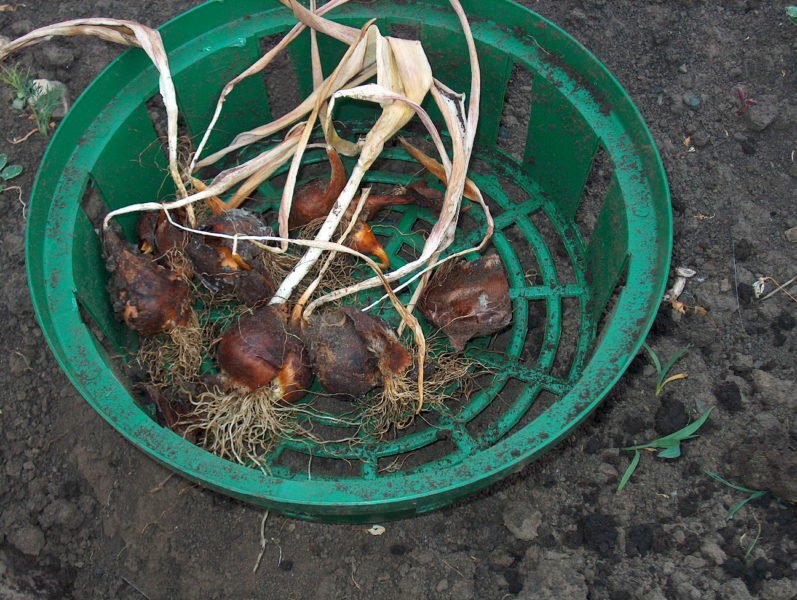
Many beginner gardeners are surprised by the need to dig up tulips, because they will have to be planted back literally in a couple of months.
However, there are a number of reasons why this rule must be observed:
- Periodically, you need to divide the nests, otherwise they will have too many bulbs. As a result, plants will have too little nutritional area, which will negatively affect their growth, development, health, flowering.
- Without digging, the bulbs gradually deepen, that is, go into the ground to an ever greater depth. Over time, they can go so far that the tulips do not have enough strength to grow through a layer of earth.
- Improvement of planting material. At each dig, the bulbs are reviewed: all sick, infected, weak ones are rejected.
- Acclimatization of plants. Tulips are thermophilic flowers. In many regions of Russia they are grown in special greenhouses. Often, the temperature of the soil in summer is insufficient for tulips, which leads to various unpleasant consequences: from loss of grade to the death of bulbs.
- An opportunity to carry out the correct processing of the soil, disinfect, prepare it for the next season.
- The tendency of tulips to rot in the soil. If you dig up the onions, then the risk of decay or infection with their infection is minimized.
- The need to move the flowerbed.Tulips are not recommended to be grown in 1 place for more than 3 years. A longer period leads to soil depletion, excessive removal of many minerals. Therefore, flowers must be periodically transplanted to another place.
Preparing tulips for digging after flowering
It is necessary to take care of the plants in advance, before the time comes to dig them up. After the tulips have faded and the leaves have turned yellow and broken, it is recommended to prune the stem. This technique will accelerate the ripening of the bulb. The optimal stem length is 2 leaves.
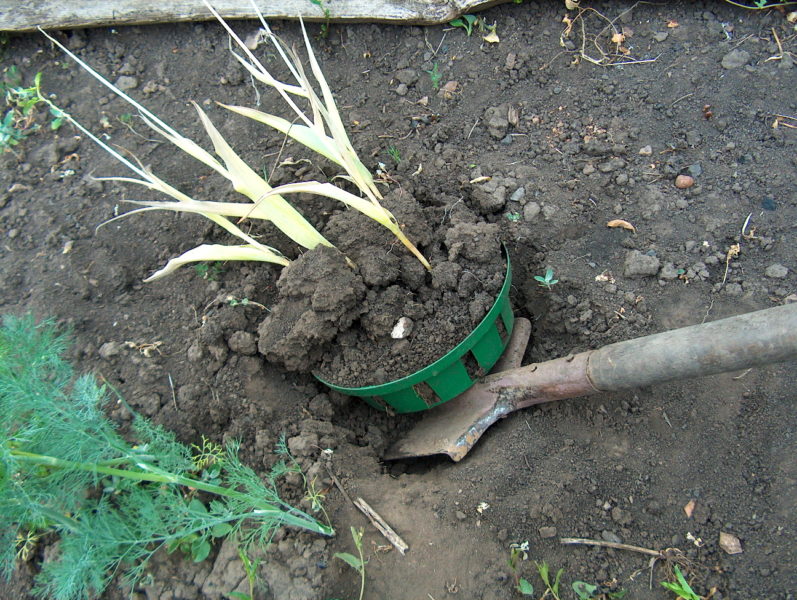
Caring for tulips after flowering in the garden consists of 2 main procedures: feeding and watering. Of course, do not forget about weeding the flower beds.
After flowering, the plant is fed with some kind of complex fertilizer containing the main mineral substances (nitrogen, phosphorus, potassium). This will increase the immunity of tulips in the future, as well as return substances removed to the soil.
Flowers like moist but not swampy soil. After pruning, tulips continue to be watered, but in small portions: up to 0.5 liters of water per 1 plant per day. To retain moisture, small grooves can be dug around plants or between rows. After watering, the grooves are again covered with earth.
When to dig out tulips after flowering?
When the tulips have faded, what to do next with them, it is up to the grower. However, digging them out right away is not recommended. This will negatively affect the ability of plants to reproduce. The underground part must ripen. Only then can you dig up tulips.
The timing of the cleaning depends on the colors themselves. On average, this is the end of June - the beginning of July. There may be a slight deviation in this rule: if spring flowering occurred later in the spring due to weather conditions, then harvesting is also postponed to a later date.
Determine that the deadline for digging bulbs has come in terms of the appearance of tulips. The plant begins to “depart”: the leaves turn yellow, break easily, the stem loses its strength and bends in all directions. The bulbs themselves are covered with hiding scales. It is light brown in color, rises slightly above the surface of the soil, so it is clearly visible. Shortly before harvesting, flower growers conduct a simple elasticity test: they wrap the stem around the finger. If at the same time it does not break, then it is time to dig up the onions. They also look at the leaves: they should turn yellow by 2/3.
Attention! Keeping the digging deadlines is extremely important. The delay will lead to damage to the bulbs by rot and infections, and if they are removed from the soil too early, the tulips will not have time to ripen, which will negatively affect the quality of planting material.
How to dig a plant?
For excavation, choose a dry sunny day. Bulbs are removed when the ground is friable and does not stick to them. Watering is stopped a week before harvesting. If damp weather does not allow the soil to dry, then after digging, the bulbs are washed in water to wash away the rest of the earth. You can use saline for these purposes (1 tbsp. L. Per 1 liter of water). This will serve as a prevention of the development of diseases. Then carefully dried planting material.
Bulbs are removed with a pitchfork, this minimizes the risk of cuts. They retreat a little from the center of the nest, stick a pitchfork and click on the handle. Bulbs will rise along with the ground. They shake the earth from them and clean it under a canopy or in a room for primary drying.
If the stem is still strong, then it is not cut off immediately, because the tops still give out nutrients. It is completely removed only after drying. In ripened onions, the scales acquire a beautiful amber-brown color. They are dense, tightly adjacent to each other.
Before harvesting, bulbs undergo primary screening and processing. If they have damage, traces of rot or infection, then such planting material is removed. Healthy bulbs are processed with potassium permanganate: a weak pink solution is prepared and for half an hour the underground part of plants is immersed in it.You can use other similar drugs: foundationazole, medex, copper chloroxide, etc.
Bulb storage conditions
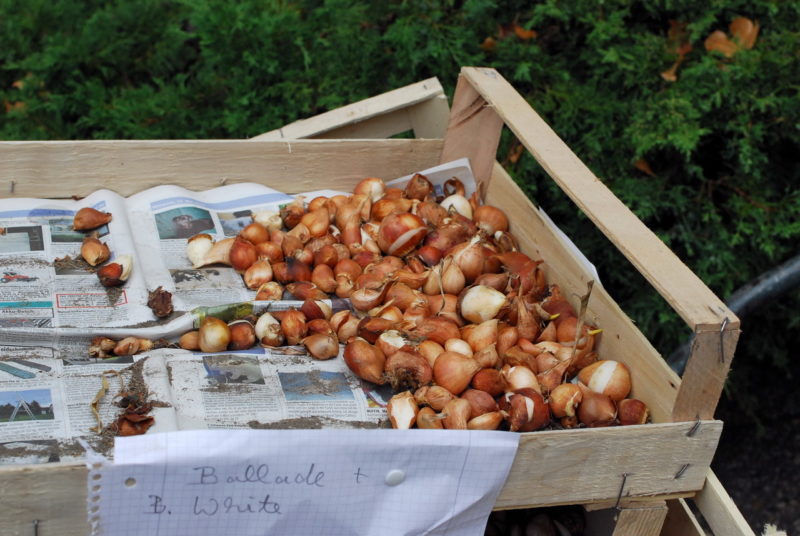
Treated onions are dried and laid out on pallets. Tulips are quite demanding on storage conditions.
Several conditions must be observed in order to preserve planting material:
- the bulbs should be well ventilated, “breathing”, so the room should have good ventilation, and the planting material itself is laid out in rows in pallets;
- the room should be dark, because the light stimulates the growth of plants;
- humidity level - not higher than 65%;
- temperature conditions: the first 4 weeks within 21-25 ° C, then it is gradually reduced. In August - up to 19 ° C, by September - up to 16 ° C;
- every 2-3 days ventilation is required;
- the room before laying the planting material must be disinfected and prepared;
- the bulbs are periodically reviewed to remove infected and diseased on time.
Culling and processing bulbs before planting
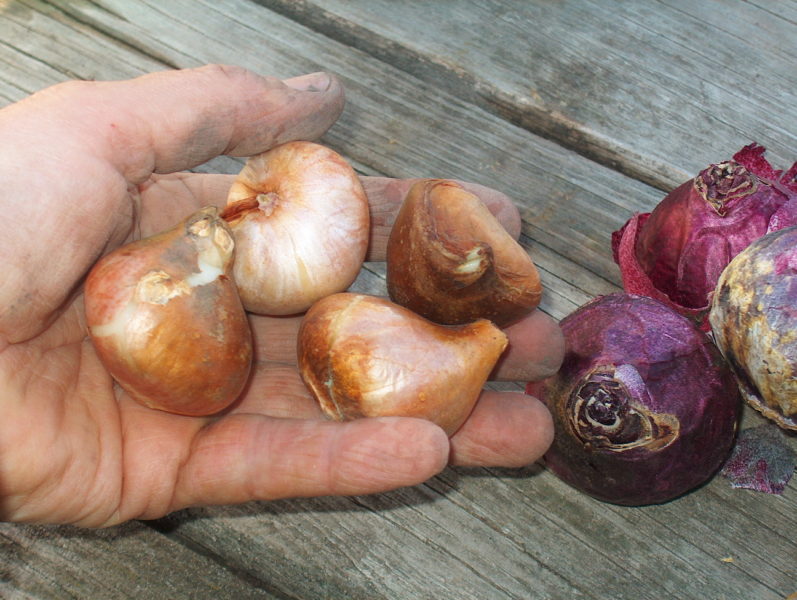
Before planting, the bulbs are re-sorted. During storage, diseases may occur. Usually they look like red-brown or gray-green spots. Fully decayed tulips may also show up. Infected planting material is thrown away or burned. If the bulbs are slightly ill, only the protective scales are affected, you can try to save them: remove the infected layer with a knife, sprinkle with crushed charcoal, and dry. Before planting, dip with saline. However, it is better to keep them away from healthy bulbs and use only if absolutely necessary, since there is a high risk of infection in the soil.
When choosing a new planting material, you must carefully examine it. If there are external signs of a disease of the bulb, you can not buy. They are also felt. Healthy bulbs are strong and evenly dense. The smell of rot, mold or any other extraneous "aroma" should not be. This produces unhealthy planting material even in the absence of visible signs of damage.
When to plant tulips
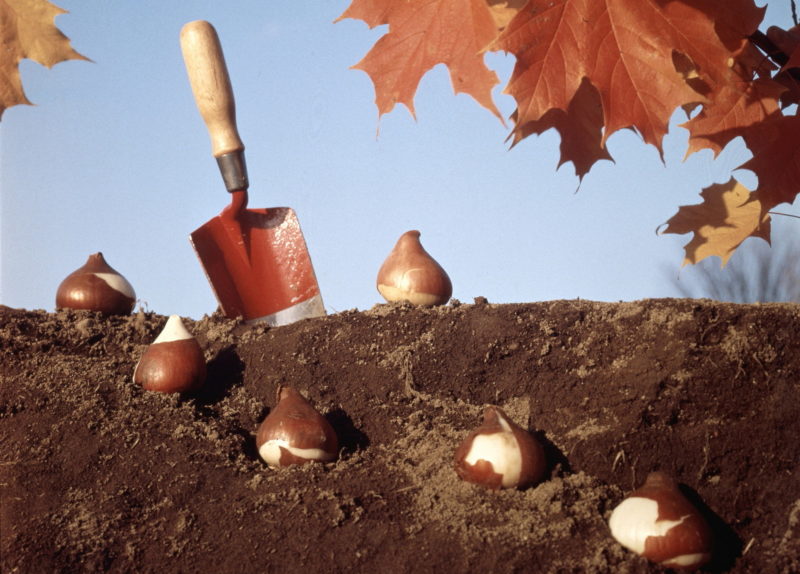
In the fall, tulip bulbs are planted in the ground. The exact dates are determined by the climatic features of the region. This must be done before the onset of autumn frosts. The average time is from mid-September to the end of the first decade of October.
Optimal conditions:
- it is cold outside;
- not quite dry soil, but loose and light;
- sunny, well-lit place;
- the depth of the hole is up to 10 cm;
- soil temperature - +10 ° C.
Tulips need 25 days to take root, therefore, planting should be carried out a month before frosts. Varietal flowers are especially sensitive to this. If they do not have time to give roots, then the plants in the spring will hurt and lag behind in development. In the worst case, they may die.












